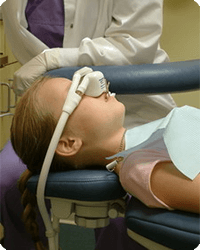A family dentist and pediatric dentist will use sedation dentistry to help patients receive the dental care that they need. It typically relaxes patients so that they can be comfortable during the procedure and lose any fears they have. It is often used in combination with local anesthesia to numb the area that is being worked on.
Those that benefit the most are people that have severe dental anxiety, are afraid of needles, do not numb easily, have had a previous bad dental experience, or need to have major dental work done. Children also benefit because it can help them to hold completely still, essential when having dental work completed. The type of sedation used and the degree to which it is used will depend on the patients age, health, the type of dental work being performed, and their overall level of anxiety.
The main types of sedation dentistry are:
Light Sedation. Most commonly, nitrous oxide is inhaled to provide a light level of sedation that helps patients to feel comfortable, but typically remain awake during the dental treatment.
General Anesthesia. This type of sedation dentistry puts a person completely to sleep. In this state of unconsciousness, people need help breathing, and it is generally only used for oral surgery.
Moderate Sedation. This can be completed by either inhaling a higher dosage of nitrous oxide or through IV sedation. Patients become so relaxed that they can respond to basic commands but won’t function like normal. This is a state of extreme relaxation.
Deep Sedation. Patients in deep sedation need help to perform basic tasks and may even need assistance breathing in case they can’t keep their airways open. This is used during more complicated procedures like placing dental implants.
The sedation itself is administered using the following methods:
General anesthesia. This will completely put a patient to sleep. You will not feel any pain or be aware of what is happening during the procedure. It is most often used for oral surgery or major dental procedures for people with severe anxiety.
IV sedation. This is less common as an anesthesiologist needs to be involved. IV sedation is also used for relaxation in combination with local anesthesia for pain.
Oral sedatives. This is extremely common and serves to relax patients. The pill can be taken either the night before or thirty minutes to an hour before having dental work done. This is for relaxation but does not help with pain relief so local anesthesia will also be given at the site of the procedure in order to numb the area.
Nitrous Oxide. More commonly known as laughing gas, this is an easy and common way to help patients relax. Simply inhale the gas to calm down and enjoy the procedure. Local anesthesia will also be used to help with pain.
During your dental examination and consultation, speak with the dentist about any dental fears that you have so that you can create a plan for treatment together. The dentist will recommend the type of sedation dentistry that they think will work best for you and work with you to keep your smile healthy while you remain comfortable.

